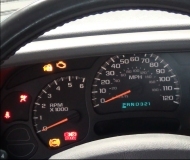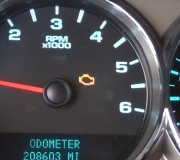The 318s used in the Fifth Ave were built to really tight tolerances compared to those used in trucks and vans. That made them very quiet and smooth-running, and it was easy to set the idle speed too low and not feel it vibrate. Also, because of the design of the transmission, nothing is cushioned when you shift into gear so they do bang kind of hard compared to other car brands. Those two things caused many people to lower the idle speed too low. If you look at the emissions sticker under the hood, it will list the desired idle speed. It's usually around 750 rpm. I had a '72 Dart once that I could get the idle down to 300 rpm and it still felt smooth. You don't ever want to keep it that low, but it shows what these engines are capable of. If raising the idle speed solves the stalling problem, there's no need to complicate the issue by reading further.
One other thing you might consider is either temporarily trying a different carburetor or checking the float level on yours. There's two ways to check the level on the car. One is to loosen the soft line nut where the fuel line attaches, to bleed off any pressure, then remove the six screws for the top cover. You can raise the cover and peek inside to see where the level is. If it's more than a half inch from the top edge of the bowl, as I recall, it's too low. Fuel can wash away from the jets on a corner and when braking and cause a lean condition. Sometimes the needle valve leaks a little and the fuel level will go up after the engine is stopped. That doesn't hurt anything but it's why loosening the steel line first to bleed any pressure off can give a more accurate result. Only about a teaspoon of gas will dribble out when you loosen that nut. Be sure to tighten it before starting the engine.
The other way to check the level is to run the engine with that cover lifted up or removed completely. The "accelerator pump" piston comes out with the cover so it won't work. That will result in a severe stumble if you try to raise engine speed. That will go away when you put it back together. Just watch that rubbery lip seal, (usually red, gray, or black), so it doesn't get caught and flip over when you reassemble it. As you push it in, you'll see and / or hear two streams of fuel spray into the engine. If that doesn't happen, remove that piston to recheck that the seal isn't flipped over.
When your mechanic rebuilt the carburetor, which mainly means cleaning the passages and replacing a few gaskets, the last step is adjusting the float height. That determines whether the fuel / air mixture is lean, rich, or correct. The procedure usually calls for holding it upside down and using a cardboard gauge to see if the floats fall down to the proper setting. I've always found that to be inaccurate and just a starting point. The final adjustment comes while running it on the car with the top cover off so you can see exactly where the fuel level is. If you took the carburetor home and installed it on the engine yourself, that fine tuning step didn't get done.
There are two floats connected together with a tab right behind and above the 1" long metal hinge pin. That tab pushes the needle valve closed to block fuel flow. As the fuel level drops, that tab allows the needle valve to open. Bending that tab is the adjustment that sets the fuel level, and it takes VERY little bending to make a big change. Bending it toward the rear of the car will increase the fuel level and reduce the stalling, assuming of course a lean condition is the reason for the stalling.
You won't see that hinge pin right away. There's a silver upside-down U-shaped strip of metal over it that holds it down when the cover is installed. You might have to hold it a little from vibrating when the engine is running. If it vibrates enough, it can let the float bounce around and let the fuel level rise to a normal level. You want to see where that level is under normal driving conditions. That means making sure the float assembly remains in place.
Those floats usually look like a a pair of little brass eggs but they could also be black plastic. Sometimes the plastic ones get "waterlogged" and sink resulting in a severe flooding condition. The engine won't run when that happens.
If you find the fuel level is too high, say within 1/8" to 1/4" from the top, you could have an excessively rich condition. The floats can hit the top cover and not be able to close the needle valve. The symptoms for that usually include black smoke from the tail pipe or poor fuel mileage.
While you're running the engine with that cover off, watch the operation of the power piston. It sits near the middle, right in front of the two holes where air goes into the engine. It is spring-loaded to rise up, and engine vacuum when it's running pulls it down. There's a pair of thin brass "metering rods" hanging down from that piston, one on each side. You should find that piston all the way down when the engine is running, and it must pop up when the engine is shut off. You can work it by hand with the engine off too. It should go down easily and come right back up when you release it. When it moves up, it enrichens the fuel mixture. That is done in response to a reduction in engine vacuum which occurs during acceleration and when idle speed gets too low. Proper operation of that piston will help the engine recover when idle speed drops too low. Improper operation typically will not cause a severe stalling problem. It more commonly causes a very slight stumble or hesitation that many people don't even notice.
One more thing to consider is that liquid gas does not burn or create power. It must be vaporized. Two things help that occur. One is the "thermactor". That is the round black thing that looks like a hockey puck on the snorkel of the air filter housing. Pop the 4" diameter fiber tube off the snorkel and watch the door just inside. As soon as you start a cold engine, that door should close off the large opening in the snorkel. That forces air to be drawn in through the flexible tube going down to the heat shield around the left exhaust manifold. That preheats the air to assist the vaporization of the gas. If that system isn't working properly or the flexible tube is missing, you typically won't notice it once the engine is warmed up unless it's really cold outside. Problems show up during engine warmup.
There is also an exhaust passage going under the automatic choke's thermostatic spring and through the intake manifold. A "heat riser valve" in the right exhaust manifold closes when it's cold and forces all of the exhaust from the right half of the engine to go through that passage and out the left side. That heat warms the choke's thermostatic spring to cause the choke to open within three minutes of start-up, and it warms the area right under the carburetor to help the fuel vaporize. If that system malfunctions, typically due to the passage being blocked by carbon buildup, the choke would not open even after driving for a half hour or longer. That used to result in severe black smoke from the exhaust, if you could even keep the engine running, and a real bad loss of power. To address that, they added an electric heater element to the choke spring. That eliminated a potential clue. To check that system, unplug the single wire going to the choke heater, then start the engine from cold. Within a minute or two you should feel the area around the choke's thermostatic spring become hot. If it doesn't, the base of the carburetor isn't being heated up either. That should also cause problems during warmup, not after driving a good 15 to 20 minutes.
Rasmataz also mentioned the EGR valve as a possible stalling problem. If your car has one it will be shown on the emissions sticker under the hood. That valve opens only at highway speed to allow inert exhaust gas into the engine to displace fresh gas and air. That reduces pollution and increases fuel mileage. You won't feel it at higher speeds, but that valve must never open at idle or low speeds. The cylinders must be packed full of fresh air and gas just to create enough power to keep the engine running. If that passage remains open, the engine will usually stall, but for sure it will idle very roughly. It is possible for the valve to stick open, but more common is a chip of carbon that breaks off and gets stuck under the valve. If you suspect a problem with that valve, an easy test is to unbolt it and reinstall it with a thin metal shim to block the passages. That is definitely not a fix. It is just a way of determining if that system is related to the stalling problem.
Many of these cars had two pickup assemblies in the distributor. One is used with retarded timing to make starting easier, then the other one is switched in by a relay for normal running. Both pickups have identical plugs that can be switched. That can result in low power, (and I suppose easy stalling), or if the distributor is turned to correct the timing, it will be too advanced during cranking. That would show up as hard starting, especially when warm. If your distributor has only one pickup, the timing change is done by the Engine Computer.
Since the mid '70s, these engines were designed to run lean, at 17:1 instead of the normal 15.7:1, hence the name "Lean Burn". Since they're already right on the edge, any type of vacuum leak will introduce even more air with no fuel to go with it and it will reduce the carburetor's ability to supply fuel. You might think about disconnecting and plugging vacuum hoses to see if there's any improvement in the stalling. A large hose goes to the power brake booster with a tap for the cruise control servo. A small plastic purple hose feeds the heater control. I found that one leaking just inside the firewall on a '78 LeBaron, the twin to your car. It had rubbed through over time. I also had one with a PCV valve that often popped apart and created a massive vacuum leak. Any vacuum leak will cause an increase in engine speed without a corresponding increase in power. If you adjust the idle speed down to correct that, there can be a big lag when you slow down before the engine speed picks back up.
Wednesday, January 11th, 2012 AT 4:13 AM





